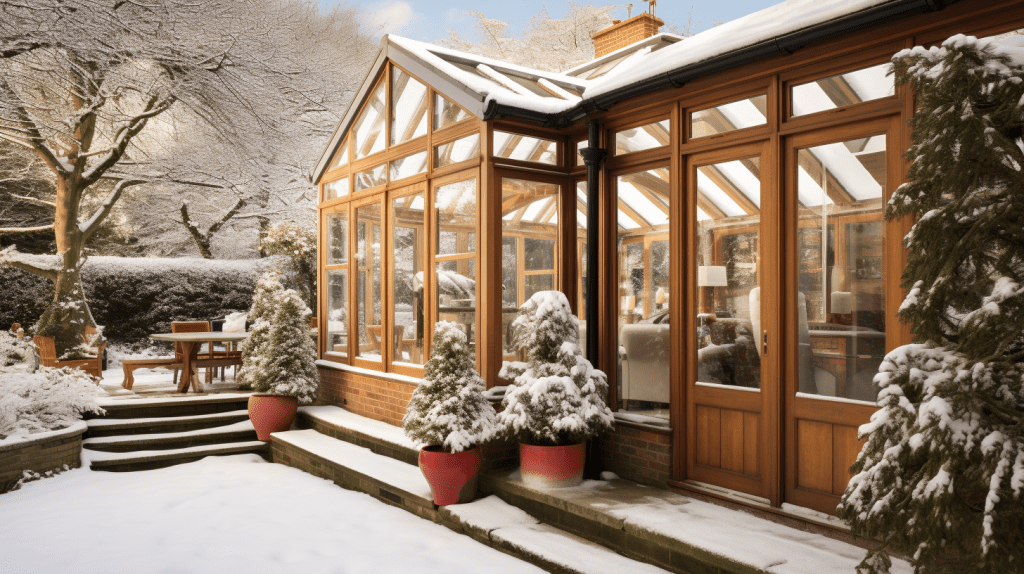A conservatory is an excellent addition to any home, offering a unique space to fully enjoy the beauty of the outdoors while remaining protected from the elements.
However, one common challenge owners face is how to keep a conservatory warm and cosy when the cold weather hits.
In this blog, we’ll explore the reasons why conservatories often get so cold and look at how to heat a conservatory. We will also highlight cost-effective and energy-efficient solutions that provide long-lasting warmth.
Want to know how to achieve the perfect temperature in your conservatory? Well, read on.
Why does my conservatory get cold?
In the winter months, conservatories can become bitterly chilly, making them unusable spaces. It can be frustrating seeing this space go to waste. There are many factors which contribute to a cold conservatory:
- Limited insulation – Conservatories are primarily made of glass or polycarbonate materials, which are poor insulators. As a result, heat can easily escape during the winter months, making the space very cold and uncomfortable.
- Heat Loss – The design of conservatories often involves a significant amount of glass, which lacks insulation and allows heat to escape quickly. This escaping heat is a key component of why these conservatories suffer such a temperature drop.
- Seasonal temperature extremes – Besides getting cold, conservatories can also be prone to overheating during the summer months. The abundance of glass in a conservatory can lead to these huge temperature fluctuations. Warm weather can cause the room to become unbearably hot, while in the winter, the glass room struggles to retain the warmth. Achieving a comfortable balance between these extremes can be challenging.
- Draughts and air leaks – Conservatories can be prone to draughts and air leaks, allowing cold air to enter and warm air to escape. This exacerbates the temperature problem.
The good news is that there are solutions to this problem.
How to keep a conservatory warm in winter and cooler in the summer
To enjoy your conservatory year-round, you must address both heating in the winter and cooling in the summer. Some methods to achieve this balance include:
Install blinds or shades
These not only block excess sunlight in the brighter weather, but they also provide an additional layer of insulation in the colder months. The downside is that these can often be expensive and require regular cleaning.
Add ceiling fans
Although seen more for their cooling properties, ceiling fans can also help distribute warm air in the winter. The issues that arise with ceiling fans are that the room aesthetics may be affected by fans that don’t fit with the design of the conservatory.
Enhance ventilation
In the colder months, there can often be problems with condensation in your conservatory. The difference in temperature between the inside and outside causes condensation to gather on the interior glass surfaces. Installing roof vents and windows that can be opened can help regulate temperature and reduce these condensation issues. However, vents and windows can lose internal heat.
Select energy-efficient glass
Low-E glass or double glazing can improve insulation and help maintain a consistent temperature. Energy-efficient glass also provides UV protection, particularly with double glazing.
However, there are some drawbacks to consider. The upfront costs are typically higher, and the limited aesthetic options may not suit every design preference. There may also be condensation issues, potential challenges in retrofitting, and reduced solar heat gain in the winter.
Choose insulated roof panels
Insulating your conservatory roof is crucial for maintaining a comfortable environment year-round. A conservatory roof is the primary source of heat loss, and without proper insulation, you can lose up to 80% of your indoor warmth.
Insulated roof panels provide an effective solution, retaining heat during winter and offering heat resistance in the summer, resulting in a consistently pleasant atmosphere. They also reduce noise and contribute to energy efficiency, leading to long-term savings.
How to Heat a Conservatory
There are several ways to heat your conservatory. Here are five popular choices, ranging from portable options to long-lasting solutions:
- Conservatory Heaters
- Log Burner
- Underfloor Heating
- Central Heating
- Conservatory Insulation
1. Conservatory Heaters
There are a few variations of conservatory heaters- Electric radiators, trench and portable.
Electric radiators are relatively easy to install, connecting to the existing pipework. They heat up and cool down quickly, making them a speedy solution. However, they can still leave some cold spots in the room, and if conservatory insulation is poor, the heat can be lost quickly.
Trench heaters are subterranean radiators placed at floor level and concealed beneath a grille. While they offer the advantage of space-saving in your room, the installation process can be quite diverse, leading to significant cost variations.
Additionally, it’s important to note that trench heaters may have a slower heating response, potentially contributing to higher energy expenses when heating a conservatory.
Electric heaters are a convenient but only temporary solution for heating a conservatory. While they can quickly warm up the space, they do come with some restrictions:
- In larger conservatories, a single heater may not distribute heat evenly across the entire space, resulting in hot and cold spots.
- Using portable heaters can pose safety risks, including the potential for overheating, fire hazards, or tripping over cords. It’s crucial to use them with caution and follow safety guidelines.
- Some portable heaters may offer limited temperature control options, making it challenging to maintain a consistent and comfortable temperature in your conservatory.
2. Log Burner
Adding a log burner to your space can create a snug and rustic ambience.
Log burners can be a focal point in your living space, becoming a conversation piece and a source of comfort during the colder months. They can also provide an alternative heating source during power outages.
It’s a traditional and aesthetically appealing option, with the crackling of the wood and flickering flames, but it does come with some challenges:
- Sourcing and storing firewood can be an added cost and a logistical challenge, particularly for those living in urban areas.
- The maintenance of these appliances, including cleaning out ashes and ensuring safe operation, takes time and effort.
- Log burners may not be the most energy-efficient heating choice. Controlling the heat output can be tricky, and if used in a poorly insulated space, such as a conservatory, a significant portion of the heat generated may be lost, leading to increased energy consumption and inefficiency.
The decision to install one should be based on a balance between the aesthetic appeal and the practical considerations of your space and lifestyle.
3. Underfloor Heating
Installing underfloor heating can achieve a consistent and balanced heat distribution within your conservatory. This system ensures an even warmth, helping with the cold spots and drafts often felt with traditional heating methods.
Controlled with a thermostat, it allows for precise temperature regulation, helping to create a more tailored climate within your space.
Its integration within your conservatory’s flooring adds to the aesthetics and functionality, ensuring a comfortable and visually appealing environment to enjoy year-round.
There are some important factors to consider. One of the most significant issues with underfloor heating is the upfront cost. The installation process can be complex and require adjustments to the existing flooring or the addition of a new floor layer. This can result in higher installation expenses compared to traditional heating systems.
It is vital to understand that underfloor heating may not be suitable for all types of flooring. Some materials, such as thick carpets or certain types of hardwood, can act as insulators, reducing the system’s efficiency. It’s essential to choose flooring materials that are compatible with underfloor heating.
Another consideration is that underfloor heating systems typically have a slower response time compared to radiators. It takes more time for the system to heat up the entire room, which can be a drawback if you want rapid changes in temperature.
The efficiency of underfloor heating systems may depend on the energy source. For instance, electric underfloor heating can be more expensive to operate than hydronic (water-based) systems, particularly in regions with high electricity costs.
4. Central Heating
Extending your central heating system to include the conservatory is a robust solution. It offers consistent warmth, can be controlled centrally, and is suitable for all seasons. However, it may require a significant initial investment and ongoing energy costs.
Extending your central heating system to include the conservatory is a robust solution.
- Central heating systems typically offer precise temperature control, allowing you to tailor the climate in your conservatory to your exact preferences, whether you want it to be warm in the winter or cool in the summer.
- This type of heating will offer consistent warmth and can be controlled centrally. It is suitable for all seasons.
- This integration ensures year-round comfort, making the conservatory an extension of your home that’s usable in all weather conditions.
- On the downside, it involves substantial upfront expenses for installation, including radiators, pipes, and a thermostat, as well as ongoing energy costs to maintain the desired temperature.
Integrating your conservatory into your central heating system in the UK provides year-round comfort and central control, but it does come with large initial and ongoing expenses.
Weigh the benefits of convenience and comfort against the associated financial investments before making your decision.
5. Conservatory Insulation
There are several methods to insulate a conservatory, but one of the most effective methods is using insulated roof panels. Insulated roofing solutions excel in temperature regulation, ensuring that your conservatory remains a comfortable and inviting living area, irrespective of external conditions.
Here are some of the benefits of conservatory roof insulation:
- Incorporating modern roofing materials, like insulated panels, significantly boosts your conservatory’s thermal efficiency. This upgrade ensures that your conservatory maintains a comfortable temperature, effectively extending your usable living space.
- The improved thermal efficiency translates to reduced reliance on heating and cooling systems. By upgrading your roof, you can enjoy long-term savings on energy bills, making it a cost-effective choice.
- Upgraded roofs often feature solar control elements that reduce glare and heat build-up, creating a more comfortable environment.
- Many advanced roofing materials provide efficient UV blocking, safeguarding your furnishings, carpets, and fabrics from fading and deterioration, thereby preserving the longevity of your interior decor.
Trusted products such as CosyPanels® feature conservatory panels constructed with a lightweight UPVC exterior surrounding a core of high-density insulation. This unique design facilitates cooler temperatures during the summer months and enhanced warmth during winter, making it an appealing choice for year-round comfort.
CosyPanels® provide a long-term, energy-efficient, and cost-effective solution to heating your conservatory. They act as both insulation and a heating source. These panels are manufactured with aluminium external layers, dense insulation, a waterproof foam core, and additional soundproofing enhancements. They can be tailored to your conservatory’s specific measurements, ensuring a perfect fit.
What is the cheapest way to heat a conservatory?
Heating a conservatory economically involves finding budget-friendly heating methods and energy-saving strategies. They are more short-term solutions. Here are some cost-effective approaches to keep your conservatory warm without breaking the bank:
- Passive solar heating: Utilise the sun’s power by ensuring your conservatory’s windows are clean and unobstructed. This allows natural sunlight to heat the space during the day, reducing the need for additional heating in the summer months.
- Draft-proofing: Seal gaps or drafts around windows and doors to prevent heat loss. Use draft excluders to create a more airtight environment.
- Thermal curtains or blinds: Install thermal curtains or blinds to trap heat and reduce heat loss during the night. These can be an affordable way to improve insulation.
- Carpets & rugs: Place rugs or carpets on the floor to add an extra layer of insulation. They help retain heat and create a warmer atmosphere.
- Heaters: Portable electric space heaters are an economical option for spot heating. However, these are only a temporary measure. Use them only when needed to save on energy costs.
- Timers: Use timers or smart thermostats to control when the heating is on and off, ensuring you’re not heating the conservatory unnecessarily.
- Proper Ventilation: Ensure your conservatory has good ventilation to prevent overheating in the summer. A well-ventilated space will be more comfortable, reducing the need for cooling.
Although some of these methods may seem cheaper, they all come with other factors that will require ongoing maintenance or running costs.
Long-term investments like CosyPanels offer a more cost-effective solution. While they may have a higher upfront cost, their energy efficiency and durability ensure lower running costs over time.
Efficiently Heating a Conservatory for the Long-Term
For an energy-efficient, long-lasting solution to heating your conservatory, CosyPanels stand out. They not only provide insulation but also generate and retain heat, offering year-round comfort.
While the initial investment may be higher than some temporary alternatives, the payoff in energy savings and comfort over the years is substantial. CosyPanels are a cost-effective choice that allows homeowners to enjoy their conservatories throughout the year, regardless of the weather outside.
Ready to transform your conservatory?
If you are looking to create a comfortable living space, request a free quote to learn more about how CosyPanels can significantly improve the energy efficiency and warmth of your conservatory all year round.
Embrace the opportunity to create a cosy and welcoming conservatory in your home.
Request Your Free Quote Now


